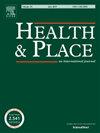住房不稳定与抑郁症状和自杀意念的关系:韩国一项针对年轻人的全国性调查的结果
IF 4.1
2区 医学
Q1 PUBLIC, ENVIRONMENTAL & OCCUPATIONAL HEALTH
引用次数: 0
摘要
适当的住房质量是幸福的基础。本研究探讨了年轻人住房不稳定性(HP)、抑郁症状和自杀意念之间的关系。对全国代表性的1.48万名年龄在19-34岁的韩国成年人进行了分析。HP是通过五个维度来衡量的:住房负担能力、住房使用权、住房满意度、社区质量和社区凝聚力。总体HP得分(从0到10)分为四个等级:最低、低、高和最高。根据患者健康问卷-9确定抑郁症状,并评估过去一年的自杀意念。Logistic回归模型计算比值比(ORs)和95%置信区间(ci)。在参与者中,5.8%报告有抑郁症状,2.4%报告有自杀念头。与HP水平最低的个体相比,HP水平高的个体(OR: 1.45;95% CI: 1.07-1.96)和最高HP水平(OR: 3.22;95% CI: 2.37-4.37)更容易出现抑郁症状。同样,HP水平最高的人产生自杀意念的几率也更高(OR: 3.38;95% ci: 2.21-5.19)。HP得分每增加1分,出现抑郁症状的几率增加1.44倍(95% CI: 1.34-1.55),报告有自杀念头的几率增加1.46倍(95% CI: 1.31-1.62)。HP与韩国年轻人的抑郁症状和自杀意念有关。因此,提高青年住房质量需要多方面的政策努力。本文章由计算机程序翻译,如有差异,请以英文原文为准。
Association of housing precariousness with depressive symptoms and suicidal ideation: Findings from a nationwide survey of young adults in South Korea
Adequate housing quality is fundamental to wellbeing. This study examined the associations between housing precariousness (HP), depressive symptoms, and suicidal ideation among young adults. A nationally representative sample of 14,800 Korean adults aged 19–34 years was analyzed. HP was measured across five dimensions: housing affordability, housing tenure, housing satisfaction, neighborhood quality, and community cohesion. An overall HP score (ranging from 0 to 10) was categorized into four levels: lowest, low, high, and highest. Depressive symptoms were determined based on the Patient Health Questionnaire-9, and suicidal ideation in the past year was evaluated. Logistic regression models calculated odds ratios (ORs) and 95 % confidence intervals (CIs). Among participants, 5.8 % reported depressive symptoms, and 2.4 % reported suicidal ideation. Compared with individuals with the lowest HP levels, individuals with high HP levels (OR: 1.45; 95 % CI: 1.07–1.96) and the highest HP level (OR: 3.22; 95 % CI: 2.37–4.37) were more likely to experience depressive symptoms. Similarly, the odds of suicidal ideation were higher among those with the highest HP level (OR: 3.38; 95 % CI: 2.21–5.19). Each 1-point increase in the HP score was associated with a 1.44-fold increase in the odds of experiencing depressive symptoms (95 % CI: 1.34–1.55) and a 1.46-fold increase in the odds of reporting suicidal ideation (95 % CI: 1.31–1.62). HP is associated with both depressive symptoms and suicidal ideation among young adults in South Korea. Therefore, multifaceted policy efforts are required to enhance housing quality of young adults.
求助全文
通过发布文献求助,成功后即可免费获取论文全文。
去求助
来源期刊

Health & Place
PUBLIC, ENVIRONMENTAL & OCCUPATIONAL HEALTH-
CiteScore
7.70
自引率
6.20%
发文量
176
审稿时长
29 days
期刊介绍:
he journal is an interdisciplinary journal dedicated to the study of all aspects of health and health care in which place or location matters.
 求助内容:
求助内容: 应助结果提醒方式:
应助结果提醒方式:


